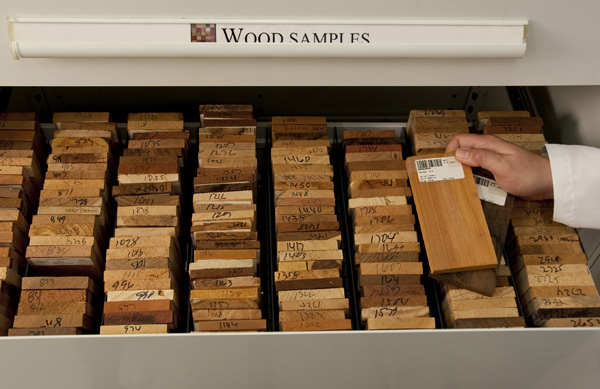
The Getty Conservation Institute’s expansive Reference Collection of Artist Materials includes well over 15,000 samples of materials used in art and the art-making process, and is still growing.
Art Kaplan is on a mission. At my request, he’s looking for a particular yellow pigment to show me—and there are hundreds of yellows to choose from, in drawers labeled Yellow Ochre, Lemon Ochre, Golden Yellow, French Yellow, and labels far too small to read from where I’m standing, stretching all the way down the length of one wall and back up the other, about 256 small drawers on each side, each containing multiple vials of different colored pigments.
Luckily, Art knows what he’s doing. He hones in on a set of drawers, pulls out a vial of rich yellow pigment from Holland and holds it up to the light, where the color glows.
Art oversees the Getty Conservation Institute’s expansive Reference Collection of Artist Materials, which includes well over 15,000 samples of materials used in art and the art making process, and is still growing. The GCI works to advance conservation practice in the visual arts, and one of the ways it serves the conservation community is through scientific research conducted in its labs. The reference collection helps GCI scientists understand the makeup of works of art that are being conserved—scientists use the file data from the reference collection to compare with data they collect from analyzing works of art from around the world.
“You really can’t conserve a piece of art unless you first understand what’s in it,” Art said. “GCI scientists can take the data analysis done on a piece of artwork—say, a painting—and compare it to the paint samples we have here in our collection. We want to be able to match the results from the analysis of an object to a particular material in the reference collection so we can identify the specific pigment, binder, resin, or other material used in the object, which in turn will affect the methods of conservation, treatment, display, and storage.”
As Art tells me this, he is standing in the climate controlled reference collection room in the basement of the GCI, ten stacked, eight-foot-high storage rows stretching nearly 22 feet long behind him, each row containing multiple drawers and shelves to hold different sets of data treasures, from pigments used in paintings to items such as wood samples (for panel painting work), tree and plant samples, fibers and silks from India and China, resins both natural (like ground amber) and synthetic, and oils like walnut and poppy seed oil.

The Getty Conservation Institute\’s Art Kaplan, examining mineral samples in the Reference Collection.
One side of an aisle contains all mineral and rock samples, which smell richly like earth as their drawers are pulled, minerals such as azurite and lapis glinting blue and green within. Open shelves on the other side contain smooth beige Ohio sandstone, Egyptian limestone, and vials of dark brown grains of earth from China, while other aisles have still more drawers to hold waxes, varnishes, proteins, gums, adhesives, solvents, glazes, dyes, photographic films, and photographic papers. The total array of samples is astonishing.
“It looks like a lot, and it is, taken all together, but these samples individually are a very small amount of material, really. We’re talking about grains of sand for many of them. The material is not interesting because of what it is, but because of the story behind it, where it came from,” Art shared.
It’s critical that the source of the material—where the material comes from, who collected it and when, is well documented in order for the database to be accurate, so labels are incredibly detailed. One sample even notes the exact hill, specific tree, and particular side of the tree from which resin was taken.

The Getty Conservation Institute’s Reference Collection of Artist Materials includes wood samples from all over the world.
Art tells me the overall collection is unique because it encompasses such a broad variety of artist’s materials, and the GCI is systematically expanding the collection every year based on the current work happening at the Institute, adding to areas where they’d like to strengthen the collection, and purchasing new materials that come on the market. He points to a large shelf containing a colorful array of newly acquired minerals that he has yet to catalogue.
A scientist’s work is never done.




Comments on this post are now closed.